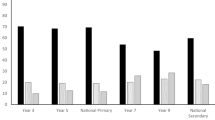Abstract
Through an examination of the higher education systems in threecountries (Indonesia, Nicaragua, and Vietnam), the authors explore howthe use of academic credits for monitoring student progress has been andcontinues to be linked to policies and institutions associated withcapitalist, market-driven economic systems. The recent histories ofthese countries and their current social and political contexts areanalyzed in relation to three interrelated themes that have emerged fromthe analysis of the three cases. These themes are: (1) Linkages topolitical and economic systems: higher education as vocationaltraining, (2) Standardization, efficiency, andtechnocracy, and (3) Who controls the curriculum? Inconclusion, the authors suggest that the academic credit system,embedded within a network of other educational practices, hastransformed the university into an institution focused on relativelynarrow, utilitarian aims rather than a more universal pursuit ofknowledge.
Similar content being viewed by others
References
Altbach, P.G. (1981). ‘The university as center and periphery’, Teachers College Record 82(4), 601–620.
Anderson-Levitt, K.M. and Alimasi, N. (forthcoming). ‘Are pedagogical ideals embraced or imposed? The case of reading instruction in the Republic of Guinea’, in Sutton, M. and Levinson, B.A. (eds.), Policy as Practice: Toward a Comparative Sociocultural Analysis of Educational Policy. Westport: Ablex Publishing, pp. 25–58.
Arnove, R.F. (1994). Education as Contested Terrain: Nicaragua 1979–1993. Boulder, CO: Westview
Arnove, R.F. (1986). Education and Revolution in Nicaragua.Praeger.
Arnove, R.F. (ed.) (1982). Philanthropy and Cultural Imperialism: The Foundations at Home and Abroad. Bloomington: Indiana University Press.
Bachtiar, H.W. (1968). ‘Indonesia’, in Emmerson, D.K. (ed.), Students and Politics in Developing Nations. New York: Frederick Praeger, pp. 180–214.
Berliner, D.C. and Biddle, B.J. (1995). The Manufactured Crisis: Myths, Fraud, and the Attack on America's Public Schools. Reading, MA: Addison-Wesley.
Bracey, G.W. (1998). ‘TIMSS, rhymes with “dims,” as in “witted”’, Phi Delta Kappan 79(9), 686–687.
CRESALC, Centro Regional para la Eduacion Superior en America Latina y el Cariba (May 1988). La Educacion Superior en Nicaragua. Caracas.
CSUCA, Consejo Superior de Universidades CentroAmericanas (1996). Documento Central del IV Congreso Universitario Centroamericano. Honduras: Tegucigalpa.
Do, K.B. (1995). ‘The difficult path toward an integrated university and community college system in Vietnam’, in Yee, A. (ed.), East Asian Higher Education: Traditions and Transformations. New York: Pergamon.
Foster, P.J. (1965). ‘The vocational school fallacy in development planning’, in Arnold, C. Anderson and Bowman, M.J. (eds.), Education and Economic Development. Chicago: Aldine Publishing, pp. 142–166.
Freire, P. (1972). Pedagogy of the Oppressed. New York: Herder & Herder.
Gorostiaga, X. (July 1993). ‘New times, new role for universities of the south’, Envio 12(144), 24–40.
Hayden, H. et al. (1967). Country Studies. Higher Education and Development in Southeast Asia,Vol.II. Paris: UNESCO Press.
Illich, I. (1971). Deschooling Society. NewYork: Harper & Row.
Johnson, K., Gaylord, W. and Chamberlin, G. (1993). Indonesia (PIER World Education Series). Washington, D.C: American Association of Collegiate Registrars and Admissions Officers, and NAFSA.
Lam, T.Q. (1993). ‘Current status of and options for strengthening and reconstructing the Vietnamese higher education system'. Seminar on Options for Reorganization of Higher Education. The World Bank and the Ministry of Education and Training of the Socialist Republic of Vietnam, Hanoi.
Levin, H.M. (1998). ‘Educational performance standards and the economy’, Educational Researcher 27(4), 4–10 Levinson, B.A.U. and Sutton, M. (forthcoming). ‘Introduction: Policy as/in practice’, in Sutton, M. and Levinson, B.A.U. (eds.), Policy as Practice: Toward a Comparative Sociocultural Analysis of Educational Policy. Westport: Ablex Publishing, pp. 1–22. Miller, V. (1985). Between Struggle and Hope: The Nicaraguan Literacy Crusade. Boulder, CO, Westview. MUCIA (1995). Higher Eductation Reform in Vietnam. Midwest University Consortium for International Activities Newsletter. Ministry of Education and Culture, Indonesia (1977). Education and Culture in Development. Jakarta: MOEC. NASSP (1998). A Report of the National Association of Secondary School Principals on the High School of the 21st Century. Republik Indonesia (1974). Lampiran: Pidato Presiden Republik Indonesia, Pelaksanaan Repelita I. Jakarta. Rudolph, F. (1977). Curriculum: A History of the American Undergraduate Course of Study Since 1636. San Francisco: Jossey-Bass. Steiner-Khamsi, G. and Quist, H.O. (2000). ‘The politics of educational borrowing: Reopening the case of Achimota in British Ghana’, Comparative Education Review 44(3), 272–300.CREDITS, CURRICULUM, AND CONTROL 137 Sutton, M. (forthcoming). ‘Policy research as ethnographic refusal: The case of women's literacy in Nepal’, in Sutton, M. and Levinson, B.A.U. (eds.), Policy as Practice: Toward a Comparative Sociocultural Analysis of Educational Policy. Westport: Ablex Publishing, pp. 77–99. Sutton, M. (1991). Social Sciences and Ordinary Understanding: Coming to Terms with Tourism in Bali. Unpublished Ph.D. dissertation, Stanford University. Thomas, R.M. (1973). A Chronicle of Indonesian Higher Education: The First Half Century, 1920–1970. Singapore: Chopmen Enterprises. Tilaar, H.A.R. (1995). 50 Tahun Pembangunan Pendidikan Nasional 1945–1995. Jakarta: P.T. Gramedia Widiasarana Indonesia. Tran, H.Q., Vu, V.T. and Sloper, D. (1995). ‘The policy-making context and policies of educa-tion and training in Vietnam’, in Sloper, D. (ed.), Higher Education in Vietnam: Change and Response. New York: St. Martin's Press, pp. 62–73. Veysey, L. (1973). 'stability and experiment in the American undergraduate curriculum’, in Kaysen, C. (ed.), Content and Context: Essays on College Education. New York: McGraw-Hill. Weischadle, D.E. (1982). ‘The Carnegie corporation and the shaping of American eduational policy’, in Arnove, R. (ed.), Philanthropy and Cultural Imperialism: The Foundations at Home and Abroad. Bloomington: Indiana University Press. World Bank (1997). Description of proposed Vietnam Higher Education Project.
Author information
Authors and Affiliations
Rights and permissions
About this article
Cite this article
Mason, T.C., Arnove, R.F. & Sutton, M. Credits, curriculum, and control in higher education: Cross-national perspectives. Higher Education 42, 107–137 (2001). https://doi.org/10.1023/A:1017525003769
Issue Date:
DOI: https://doi.org/10.1023/A:1017525003769




